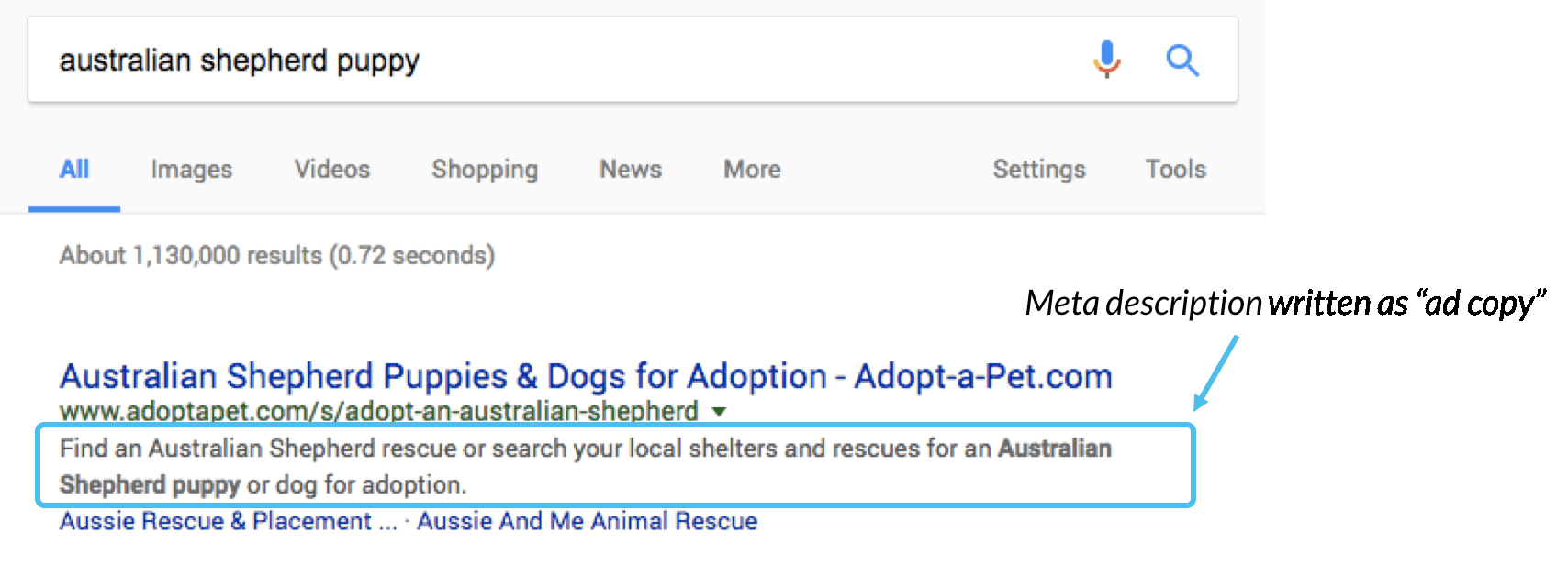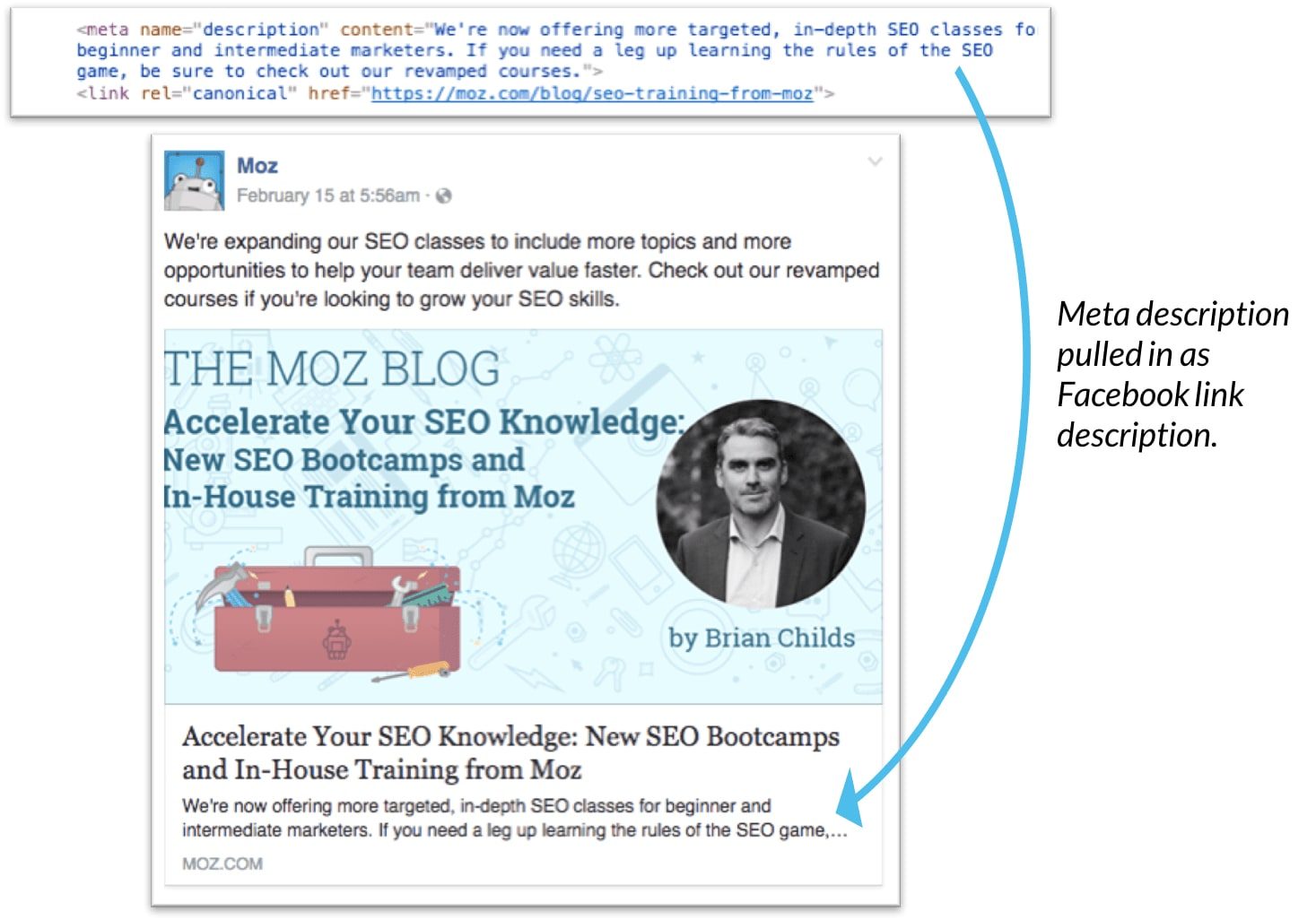Meta Description
What is a meta description?
Meta descriptions are HTML attributes that provide concise summaries of webpages. They are between one sentence to a short paragraph and appear underneath the blue clickable links in a search engine results page (SERP). However, depending on a user's query, Google might pull meta description text from other areas on your page (in an attempt to better answer the searcher's query).
Example:

Code sample
<head> <meta name="description" content="This is an example of a meta description. This will often show up in search results."> </head>
Optimal length
Meta descriptions can be any length, but Google generally truncates snippets ~300 characters (this limit increased in December 2017). It's best to keep meta descriptions long enough that they're sufficiently descriptive, so we recommend descriptions between 50–300 characters. Keep in mind that the "optimal" length will vary depending on the situation, and your primary goal should be to provide value and drive clicks.
Optimal format
Meta description tags, while not tied to search engine rankings, are extremely important in gaining user click-through from SERPs. These short paragraphs are a webmaster's opportunity to "advertise" content to searchers, and searchers' chance to decide whether the content is relevant and contains the information they're seeking from their search query.
A page's meta description should intelligently (read: in a natural, active, non-spammy way) employ the keywords that page is targeting, but also create a compelling description that a searcher will want to click. It should be directly relevant to the page it describes, and unique from the descriptions for other pages.
Google ranking factor?
Google announced in September of 2009 that neither meta descriptions nor meta keywords factor into Google's ranking algorithms for web search.
Meta descriptions can however impact a page's CTR (click-through-rate) on Google which can positively impact a page's ability to rank.
For that reason, among others, it's important to put some effort into meta descriptions.
SEO best practices
Write compelling ad copy
The meta description tag serves the function of advertising copy. It draws readers to a website from the SERP, and thus is a very visible and important part of search marketing. Crafting a readable, compelling description using important keywords can improve the click-through rate for a given webpage. To maximize click-through rates on search engine result pages, it's important to note that Google and other search engines bold keywords in the description when they match search queries. This bold text can draw the eyes of searchers, so you should match your descriptions to search terms as closely as possible.

Avoid duplicate meta description tags
As with title tags, it's important that meta descriptions on each page be unique. Otherwise, you'll end up with SERP results that look like this:

One way to combat duplicate meta descriptions is to implement a dynamic and programmatic way to create unique meta descriptions for automated pages. If possible, though, there's no substitute for an original description that you write for each page.
Don't include double quotation marks
Any time quotation marks are used in the HTML of a meta description, Google cuts off that description at the quotation mark when it appears on a SERP. To prevent this from happening, your best bet is to remove all non-alphanumeric characters from meta descriptions. If quotation marks are important in your meta description, you can use the HTML entity rather than double quotes to prevent truncation.
Sometimes it's okay to not write meta descriptions
Although conventional logic would hold that it's universally wiser to write a good meta description rather than let the engines scrape a given web page, this isn't always the case. Use this general rule of thumb to identify whether you should write your own meta description:
If a page is targeting between one and three heavily searched terms or phrases, write your own meta description that targets those users performing search queries including those terms.
If the page is targeting long-tail traffic (three or more keywords), it can sometimes be wiser to let the engines populate a meta description themselves. The reason is simple: When search engines pull together a meta description, they always display the keywords and surrounding phrases that the user has searched for. If a webmaster writes a meta description into the page's code, what they choose to write can actually detract from the relevance the engines make naturally, depending on the query.
One caveat to intentionally omitting meta description tags: Keep in mind that social sharing sites like Facebook commonly use a page's meta description tag as the description that appears when the page is shared on their sites. Without the meta description tag, social sharing sites may just use the first text they can find. Depending on the first text on your page, this might not create a good user experience for people encountering your content via social sharing.

Heads up: Search engines won't always use your meta description
In some cases, search engines may overrule the meta description a webmaster has specified in the HTML of a page. Precisely when this will happen is unpredictable, but it often occurs when Google doesn't think the existing meta description adequately answers a user's query and identifies a snippet from the target page that better matches a searcher's query.
Keep learning
Put your skills to work
Moz Pro's Page Optimization tool provides insight the other factors of a page that you can optimize to improve their chances of ranking well. Try it >>